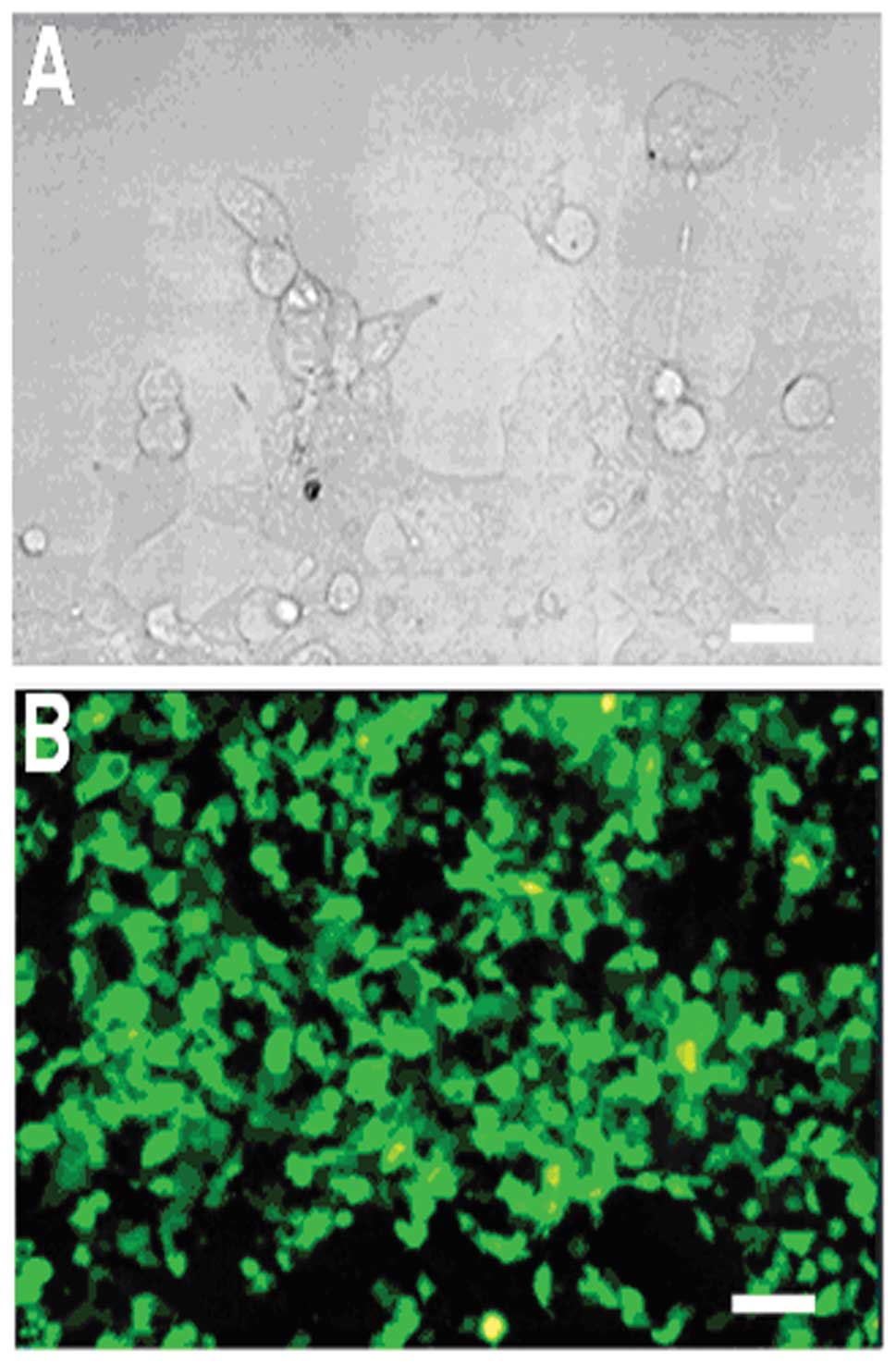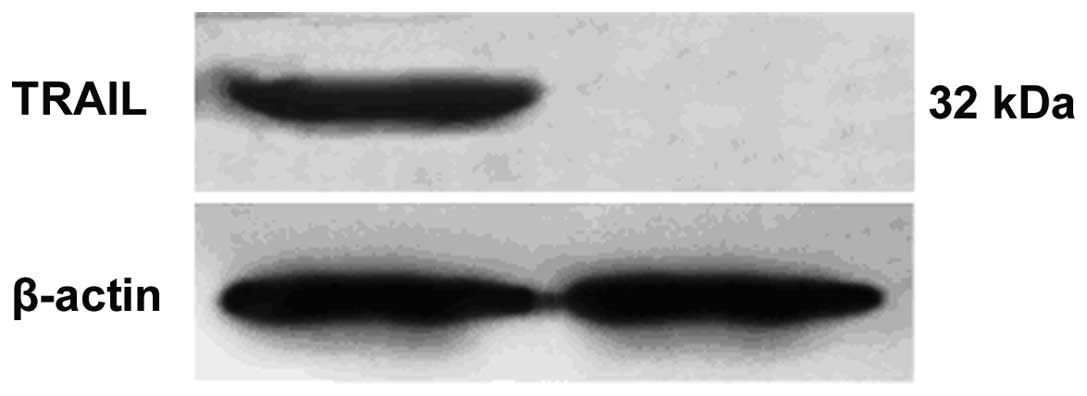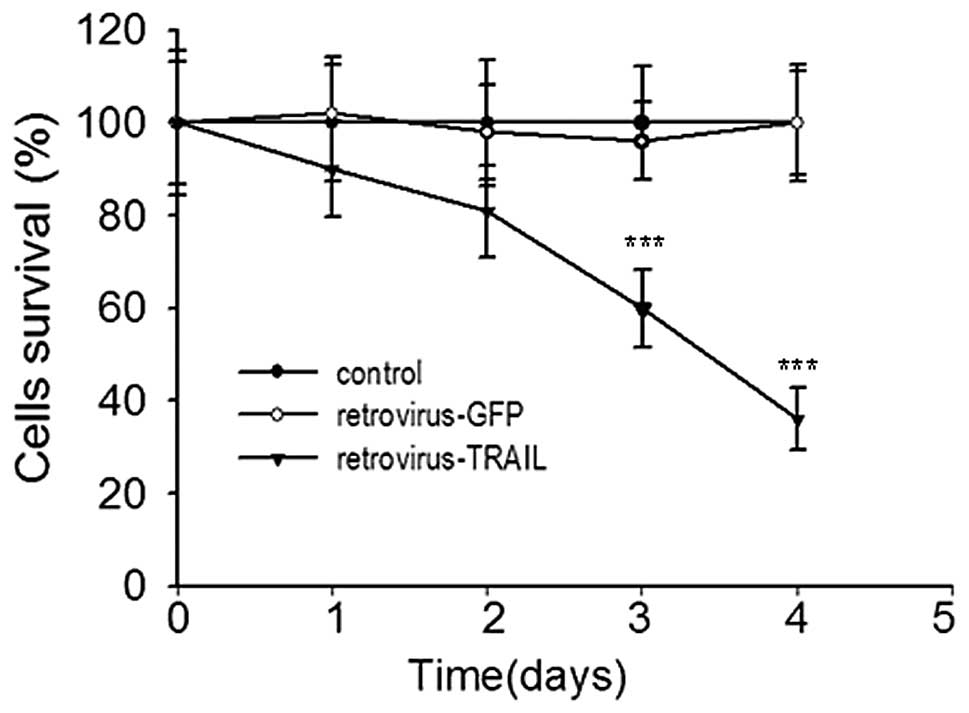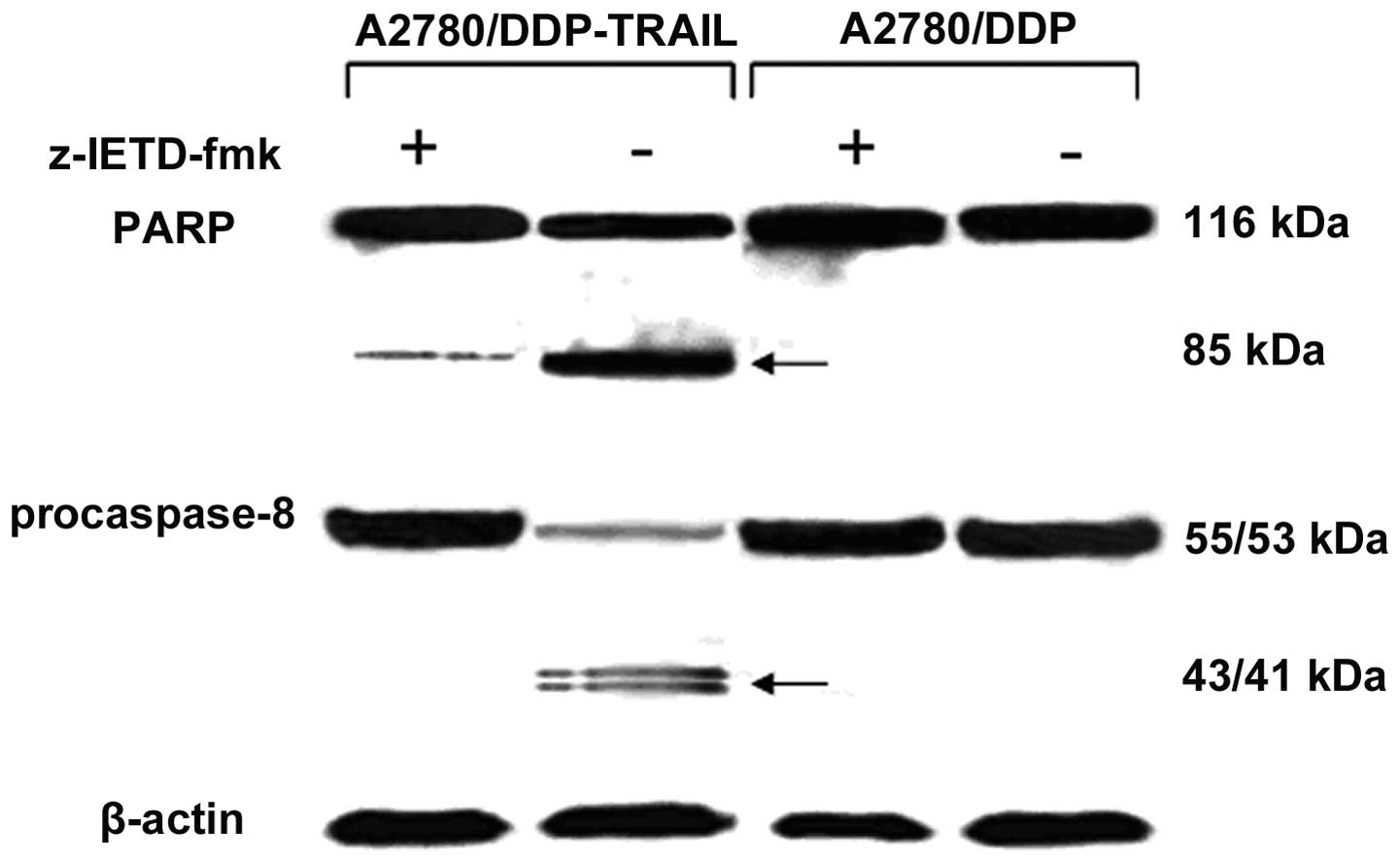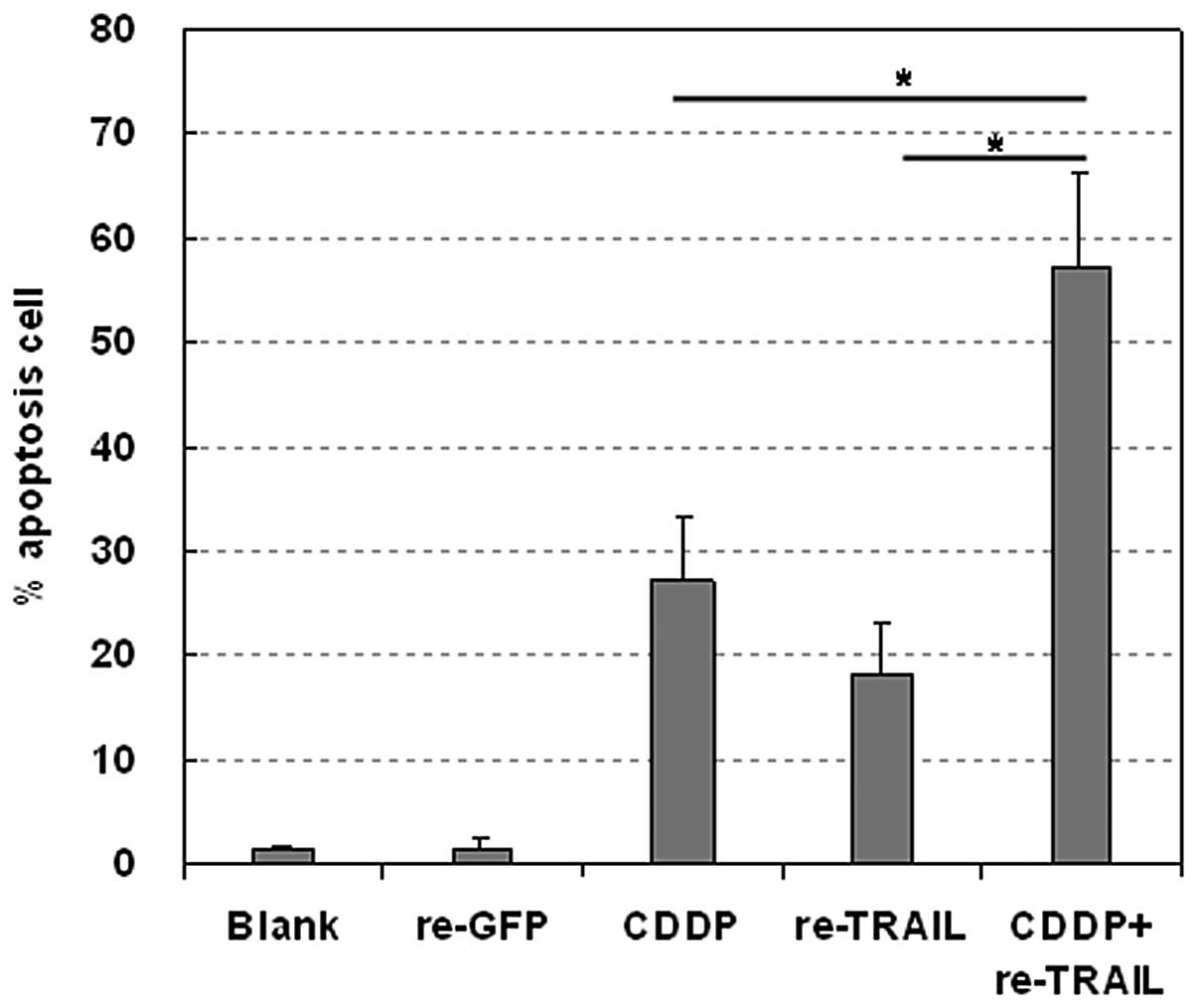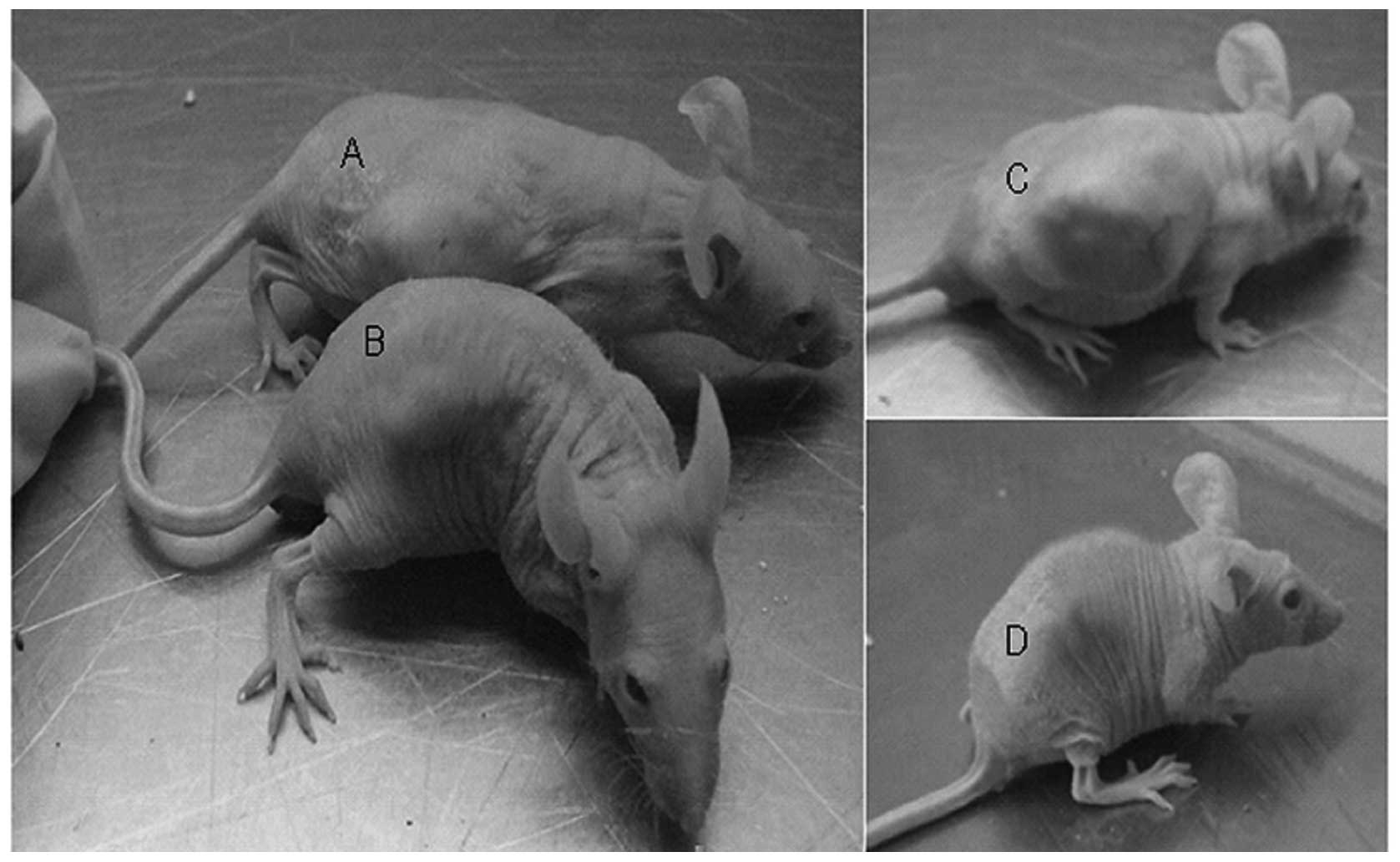Introduction
Ovarian carcinoma is the fifth most common
gynecological cancer (1). Due to
the lack of an efficient method for early diagnosis of ovarian
cancer, the cancer is often detected in an advanced stage. In this
situation, the patients usually have to undergo surgry to remove
the tumor and receive chemotherapy using anticancer drugs, such as
cisplatin and doxorubicin. In a number of cases, chemotherapy is,
however, often discontinued due to intrinsic or developed drug
resistance of ovarian cancer cells (2–4). In
order to obtain improved anticancer efficacy, chemotherapy in
combination with a biological therapy has been studied in the past
decade. This type of combined therapy was demonstrated to be more
efficacious than either chemotherapy or biological therapy alone.
For instance, a combination of an anticancer drug and trastuzumab,
a monoclonal antibody capable of interfering with the HER2/neu
receptor, led to enhanced growth suppression of breast cancer cells
compared with anticancer drug alone (5). Besides, a previous study suggested
that a combined use of anticancer drug with the TNF-related
apoptosis-inducing ligand (TRAIL) protein had a synergistic effect
on the apoptotic activity in ovarian cancer cells (6).
TRAIL is a promising anticancer protein which is
capable of inducing specific apoptosis in a broad range of cancer
cells, but not in normal cells (7–9).
However, the clinical use of TRAIL protein is seriously impeded due
to its instability in vivo and the resistance of cancer
cells to the TRAIL (10,11). To obtain favorable tumor growth
inhibition, a high dose of the protein has to be administrated
in vivo (10). As an
alternative approach, virus-mediated TRAIL gene therapy has been
investigated recently (12). This
is attributed to the fact that viruses are able to transfer genes
into somatic cells, thereby yielding highly efficient gene
transfection. On the basis of this principle, Griffith et al
constructed a TRAIL-encoded adenovirus and found that the virus may
lead to TRAIL expression in cancer cells and to their death
mediated by caspase-8-activated apoptosis (13). Furthermore, another study showed
that an adenovirus-TRAIL may augment apoptosis in TRAIL-resistant
cancer cells, including SKOV-3 ovarian cancer cells (14). These data indicate that
virus-mediated TRAIL gene therapy may be promising for ovarian
cancer therapy.
Recently, a few studies have been published on the
chemotherapy drug in combination with TRAIL gene therapy for
efficacious cancer therapy. For example, a previous study by Pan
et al illustrated that a combined use of cisplatin with an
oncolytic adenovirus-TRAIL resulted in synergistic growth
inhibition of several types of cancer cell lines (15). Several other studies have proposed
that chemotherapy drugs, such as cisplatin, may sensitize
TRAIL-induced cytotoxicity in breast cancer cells or glioma cells,
both in vitro and in vivo (16,17).
However, to the best of our knowledge, it is not well understood
whether the combination of chemotherapy and TRAIL gene therapy can
be applied to drug-resistant ovarian carcinoma cells.
In this study, we generated a recombinant
retrovirus-encoding TRAIL gene via TRAIL-plasmid transfection of
the retrovirus packaging cell line BOSC 23. This virus was then
used for the transduction of drug-resistant A2780/DDP ovarian
carcinoma cells. The expression of the TRAIL gene in the cells was
detected by western blot assay. The effect of the TRAIL on the
in vitro growth of the retrovirus-transduced A2780/DDP cells
was studied. Also, the growth-inhibitory effect of cisplatin in
combination with the retrovirus-TRAIL was investigated in the
xenograft A2780/DDP tumor in a nude mouse model.
Materials and methods
Cell culture
Retrovirus packaging BOSC 23 cells were cultured in
the GPT-selective medium as previously described (18). Cisplatin-resistant A2780/DDP cells
were maintained in DMEM (Gibco, Carlsbad, CA, USA) with 10% fetal
calf serum.
Recombinant retroviral vectors
Human TRAIL cDNA was kindly provided by Dr H. Yagita
(Juntendo University School of Medicine, Japan). MSCV-IRES2-GFP
plasmid was a gift from Dr R. Davis (University of Massachusetts,
MA, USA). MSCV-TRAIL-IRES2-GFP plasmid was constructed by
subcloning the TRAIL cDNA into the EcoRI site of the
MSCV-IRES2-GFP plasmid as previously described (19).
Construction of retrovirus-TRAIL
Retrovirus-TRAIL was generated by calcium
phosphate-mediated transient transfection of retrovirus packaging
BOSC 23 cells using MSCV-TRAIL-IRES2-GFP plasmid (20). Specifically, BOSC 23 cells
(2.6x106 cells) were plated in a 60-mm dish for at least
24 h. Prior to cell transfection, cell culture medium was replaced
with GPT-selective medium containing chloroquine (50 μM).
Subsequently, the cells were incubated with the coprecipitate of
calcium phosphate and the plasmid (8 μg) for 8 h at 37°C in
a humidified 5% CO2-containing atmosphere. Following
this, the cell culture medium was replaced with fresh DMEM-complete
medium and the cells were incubated for a further 16 h. Expression
of GFP was detected by Nikon fluorescence microscopy. Finally,
viral supernatant was collected after centrifugation at 1,200 rpm
for 5 min at 4°C and stored at −20°C. Retrovirus-GFP without
encoding TRAIL was also produced by the same procedure as mentioned
above and used as a negative control. Viral titer was determined by
flow cytometry (Beckton-Dickinson, San Jose, CA, USA) as previously
described (19).
Construction of
retrovirus-TRAIL-transduced A2780/DDP cells
A2780/DDP cells (1x104 cells per well)
were plated in a 96-well plate with 200 μl DMEM-complete
medium containing 10% fetal calf serum for at least 24 h. Then, the
medium was replaced with viral supernatant (125 μl),
polybrene (4 μg/ml) and fresh cytokines. After 24 h of
infection, the cells were washed and resorted for GFP expression
using FACScan. Individual clones showing a high level of GFP
expression were selected by dilution cloning. Briefly, after flow
cytometry analysis, pools of A2780/DDP cells were collected and
plated in a 96-well plate with one to three cells per well. After
incubation for several days, a single colony was identified under
light microscopy and then further cultured in a 35-mm dish. The
clones that demonstrated a high level of GFP expression were used
for further study. Retrovirus-GFP-transduced A2780/DDP cells
without expressing TRAIL were also constructed by the same
procedure as mentioned previously and used as a negative
control.
MTT assay
Retrovirus-TRAIL-transduced,
retrovirus-GFP-transduced A2780/DDP cells and untreated A2780/DDP
cells as a control (1.0×104 cells per well) were seeded
into a 96-well plate. Cell survival, determined by MTT assay, was
studied as a function of incubation time from 1 to 5 days. At
different time intervals (days 1 to 5), MTT solution (20 μl,
5 mg/ml) was added to each well and incubated with the cells for 4
h. Afterwards, the medium was removed and DMSO (150 μl) was
added to each well. The absorbance was measured at 570 nm using a
plate reader (Thermo Scientific, Logan, UT, USA). The percentage of
cell viability was determined relative to control cells (untreated
A2780/DDP cells), and taken as 100% cell viability. All
cytotoxicity experiments were performed eight times.
Western blot analysis
Retrovirus-TRAIL-transduced or
retrovirus-GFP-transduced A2780/DDP cells were cultured in the
absence or presence of caspase inhibitor zVAD-fmk for 3 days, then
lysed and protein was extracted. Total protein was quantified by
BCA protein assay kit (Promega Corporation, Madison, WI, USA). For
western blot analysis, equal amounts of protein were separated by
SDS-PAGE, transferred onto nitrocellulose membranes (Millipore,
Bedford, MA, USA), blocked and incubated overnight with mouse
monoclonal primary antibody. After washing, the membrane was
incubated with horseradish peroxidase-labeled anti-mouse secondary
antibody. Finally, the bands were visualized using the enhanced
chemiluminescence kit (Amersham Biosciences) according to the
manufacturer’s instructions.
Apoptosis analysis
Sub-G1 proportion assays were performed to confirm
apoptosis in A2780/DDP cells by retrovirus-TRAIL. Briefly,
retrovirus-TRAIL-transduced A2780/DDP cells,
retrovirus-GFP-transduced A2780/DDP cells and untreated A2780/DDP
cells (control) were cultured. After 48 h, the cells were stained
according to the manufacturer’s instructions (CycleTest plus kit,
Becton-Dickinson). The apoptotic cells were determined by counting
the sub-G1 portion using a FACScan (Beckton-Dickinson) and the
percentage of apoptotic cells was analyzed with CELL-Quest Version
3.3 software.
Animal study
Nude mice were housed in the animal facility at
Tongji University. All research was approved by the Institutional
Animal Care and Use Committee at the University.
In order to generate tumors, 50 μl of
2×106 single-cell suspension in 5% PBS was injected
subcutaneously into the backside of 4- to 6-week Balb/c nude mice
of four groups (n=6 for each group). A2780/DDP cells were used in
groups 1 (control) and 2 and retrovirus-TRAIL-transduced A2780/DDP
cells were used in groups 3 and 4. Treatment of tumors started at
day 14 when the size of the tumors reached 800–1,000
mm3. At day 14, the chemotherapy drug cisplatin (CDDP)
was administered to those mice of groups 2 and 4. The tumor size
was measured at day 40, using a caliper across its longest (a) and
shortest (b) diameters, and was calculated by the following
equation: V = 0.5a × b2.
Statistical analysis
Statistical differences between the experimental
data of two groups were analyzed using a Student’s t-test. Data
were considered to be statistically significant at P<0.05.
Results
Production of high-titer helper-free
retrovirus expressing TRAIL
In this study, retroviruses that are encoded by
TRAIL genes (retrovirus-TRAIL) were produced by calcium
phosphate-mediated transfection of retrovirus packaging BOSC 23
cells using a TRAIL-GFP-encoded plasmid. This plasmid contains GFP
gene reporter as an indicator of cell transfection. Prior to the
transfection, coprecipitates of calcium phosphate/TRAIL-plasmid
were formed in situ by drop-wise addition of the
plasmid/CaCl2 solution into the cell culture medium.
After 16 h of transfection, hypertrophy was observed for the BOSC
23 cells (Fig. 1A), indicating the
cellular internalization of the coprecipitates. After 48 h of
transfection, 80–90% BOSC 23 cells expressing GFP were observed
under fluorescence microscopy (Fig.
1B). Eventually, the retroviruses were collected from the
supernatant of the cell solution. Typical titer of the retrovirus
was determined to be 1.96±0.37×106 TU/ml (19).
TRAIL led to the growth inhibition of
drug-resistant A2780/DDP cells via caspase-activated apoptosis
Drug-resistant A2780/DDP ovarian cancer cells were
transduced by the retrovirus-TRAIL and an individual clone showing
a high level of GFP expression was sorted with flow cytometry. The
protein from the cell lysate was separated with SDS-PAGE and
immunoblotted for TRAIL. A 32-kDa protein band was observed
(Fig. 2). The size of the protein
was consistent with that of TRAIL in a transmembrane form (13). Cell viability of
retrovirus-TRAIL-transduced A2780/DDP cells as a function of
incubation time was determined by MTT assay (Fig. 3). It was shown that cell viability
significantly decreased from 83±7.2% to 36±6.7% when increasing the
time from 1 to 5 days. By contrast, no cytotoxicity was observed
for retrovirus-GFP-transduced or untreated A2780/DDP cells
(Fig. 3).
TRAIL protein may induce apoptosis in cancer cells
by a caspase-dependent mechanism (20). To ascertain whether TRAIL-induced
apoptosis in A2780/DDP cells was due to triggering of the caspase
cascade, caspase-8 and PARP cleavage products in the cells were
detected by western blot assay. As shown in Fig. 4, caspase-8 was activated by the
cleavage of a 55/53-kDa precursor into 43/41-kDa products.
Activated caspase-8 then cleaved PARP from a 116-kDa protein into
an 85-kDa cleavage product. Besides, the presence of caspase
inhibitor zVAD-fmk resulted in the loss of these cleavage products
in the cells. As a negative control, these cleavage products were
absent from the retrovirus-GFP-transduced A2780/DDP cells.
Cisplatin in combination with
retrovirus-TRAIL may augment apoptosis in A2780/DDP cells
Effects of the retrovirus-TRAIL, alone or in
combination with cisplatin, on the growth of the A2780/DDP cells
were studied in vitro. The percentage of apoptotic cells was
detected with sub-G1 proportion assay and determined by flow
cytometry (Fig. 5).
Retrovirus-TRAIL and cisplatin resulted in 18.3±5.0% and 27.3±5.9%
apoptotic cells, respectively. By contrast, exposure of such cells
to the retrovirus-TRAIL and cisplatin induced a higher percentage
of apoptotic cells (57.2±9.2%).
Retrovirus-TRAIL inhibits A2780/DDP tumor
growth in a nude mouse model
A preliminary in vivo study was performed to
evaluate the antitumor activity of retrovirus-TRAIL. Tumors were
established by subcutaneous injection of either A2780/DDP cells or
retrovirus-TRAIL-transduced A2780/DDP cells into the backside of
nude mice. A2780/DDP cells formed appreciable tumors at day 10 in
all mice. By contrast, retrovirus-TRAIL-transduced A2780/DDP cells
formed visible tumors at a later time (day 12) in 4 out of 6 nude
mice. At day 14, anticancer drug cisplatin was administrated to
these mice via i.v. injection. Tumor size was measured at day 40
(Fig. 6; Table I). The tumor size of
retrovirus-TRAIL-treated A2780/DDP cells was smaller than that of
untreated A2780/DDP cells alone (729±10.1 vs. 3375±23.3
mm3). It was also found that the combination treatment
of the A2780/DDP tumor with cisplatin and retrovirus-TRAIL resulted
in the highest antitumor activity (27±1.7 mm3).
 | Table I.Growth inhibition of drug-resistant
A2780/DDP cells inoculated in nude mice. |
Table I.
Growth inhibition of drug-resistant
A2780/DDP cells inoculated in nude mice.
| Group no. | Treatment | Tumor volume
(mm3) |
|---|
| 1 | Control | 3375±23.3 |
| 2 | CDDP | 1301±21.0 |
| 3 |
Retrovirus-TRAIL | 729±10.1 |
| 4 | Retrovirus-TRAIL +
CDDP | 27±1.7a |
Discussion
TNF-related apoptosis-inducing ligand (TRAIL), also
known as Apo2L, is a type II integral membrane protein belonging to
the TNF family. It is a promising agent for cancer therapy owing to
its capability of inducing apoptosis in numerous cancer cell lines,
but little adverse effect on most normal cells. However, clinical
use of TRAIL protein is seriously limited due to its instability
in vivo and the resistance of cancer cells. TRAIL gene
therapy provides an alternative approach. Viral vectors are potent
to transfer therapeutic genes into the cancer cells, thus resulting
in a high level of gene expression. Adenoviral vectors carrying the
TRAIL gene were reported that may lead to apoptosis in cancer cells
and a bystander effect (14).
In this study, we sought to investigate the
possibility of chemotherapy in combination with TRAIL gene therapy
for drug-resistant ovarian cancer. Firstly, TRAIL-encoded
retrovirus was generated by calcium phosphate-mediated
TRAIL-plasmid transient transfection of the retrovirus packing cell
line BOSC 23 (Fig. 1). In a
previous study, high-titer retrovirus was produced from the
retrovirus packing cell line by the transient gene transfection
(20). As a result, retroviruses
carrying TRAIL gene were generated with a high titer
(1.96x106 TU/ml). To the best of our knowledge, this is
the first report on the production of TRAIL-encoded retrovirus.
Western blot analysis showed that TRAIL protein
(32-kDa) was produced in the drug-resistant A2780/DDP cells
transduced by the retrovirus-TRAIL (Fig. 2), suggesting the expression of TRAIL
gene in the cells. Moreover, the TRAIL protein resulted in
significant growth inhibition of the A2780/DDP cells, when the
transduced cells were cultured from 1 to 5 days (Fig. 3). It was expected that the
appreciable growth suppression may be due to TRAIL-mediated cell
apoptosis via a caspase-activated mechanism. As evidence of this,
caspase-8 and PARP cleavage products in retrovirus-TRAIL-transduced
A2780/DDP cells were detected by western blot assay. The results in
Fig. 4 indicate that A2780/DDP
growth inhibition by retrovirus-TRAIL may be due to the induction
of caspase-8 activated apoptosis. Support for this hypothesis was
also found in the western blot obtained in the presence of caspase
inhibitor zVAD-fmk. As expected, the inhibitor efficiently led to
the loss of these cleavage products. These data are in line with
the results from Seol et al who revealed that TRAIL protein
is capable of inducing caspase-8-dependent apoptosis in Jurkat
cells (22).
The combinatory effect of cisplatin with
retrovirus-TRAIL was studied in A2780/DDP cells in vitro and
in vivo. The in vitro study showed that cisplatin in
combination with the retrovirus-TRAIL led to a higher percentage of
apoptotic cells compared with retrovirus-TRAIL or cisplatin alone
(Fig. 5). Furthermore, a
preliminary in vivo study revealed that the combination
treatment of A2780/DDP tumor with cisplatin and the
retrovirus-TRAIL induced the highest antitumor activity (Fig. 6; Table
I). These data suggest that a combination of chemotherapy and
TRAIL-gene therapy may be an efficient approach to killing
drug-resistant ovarian cancer cells.
We have demonstrated that high-titer, TRAIL-encoded
retrovirus may be generated by TRAIL-plasmid transfection of
retrovirus packing cells BOSC 23. The retroviruses were able to
transduce drug-resistant A2780/DDP ovarian carcinoma cells and to
induce the TRAIL-gene expression and their growth inhibition in
vitro via caspase-8-activated apoptosis. Moreover, the
chemotherapy drug cisplatin, in combination with retrovirus-TRAIL,
may lead to augmented growth inhibition of A2780/DDP cells in
vitro and of the xenograft A2780/DDP tumor in a nude mouse
model.
Acknowledgements
This study was supported by grants
from the Health Bureau of Shanghai (No.20114150), Innovation
Program (No. 11QA1405200) and National Natural Science Foundation
of China (No. 81001153).
References
|
1.
|
SH LandisT MurrayS BoldenPA WingoCancer
statistics, 1999CA Cancer J
Clin49831199910.3322/canjclin.49.1.8
|
|
2.
|
SH KaufmannWC EarnshawInduction of
apoptosis by cancer chemotherapyExp Cell
Res2564249200110.1006/excr.2000.4838
|
|
3.
|
DE FisherApoptosis in cancer therapy:
crossing the
thresholdCell78539542199410.1016/0092-8674(94)90518-58069905
|
|
4.
|
CA SchmittSW LoweApoptosis is critical for
drug response in vivoDrug Resist
Updat4132134200110.1054/drup.2001.018811512522
|
|
5.
|
J BaselgaL NortonJ AlbanellYM KimJ
MendelsohnRecombinant humanized anti-HER2 antibody (Herceptin)
enhances the antitumor activity of paclitaxel and doxorubicin
against HER2/neu overexpressing human breast cancer
xenograftsCancer Res58282528311998
|
|
6.
|
M CuelloSA EttenbergMM NauS
LipkowitzSynergistic induction of apoptosis by the combination of
TRAIL and chemotherapy in chemoresistant ovarian cancer
cellsGynecol Oncol81380390200110.1006/gyno.2001.619411371126
|
|
7.
|
CG FerreiraM EppingFA KruytG
GiacconeApoptosis: target of cancer therapyClin Cancer
Res820242034200212114400
|
|
8.
|
JP SheridanSA MarstersRM PittiControl of
TRAIL-induced apoptosis by a family of signaling and decoy
receptorsScience277818821199710.1126/science.277.5327.8189242611
|
|
9.
|
A AshkenaziTargeting death and decoy
receptors of the tumour-necrosis factor superfamilyNat Rev
Cancer2420430200210.1038/nrc82112189384
|
|
10.
|
H WalczakRE MillerK AriailTumoricidal
activity of tumor necrosis factor related apoptosis-inducing ligand
in vivoNat Med5157163199910.1038/55179930862
|
|
11.
|
MA GrotzerA EggertTJ ZuzakResistance to
TRAIL-induced apoptosis in primitive neuroectodermal brain tumor
cells correlates with a loss of caspase-8
expressionOncogene1946044610200010.1038/sj.onc.1203816
|
|
12.
|
H MaY LiuS LiuHF KungX SunD ZhengR
XuRecombinant adeno-associated virus-mediated TRAIL gene therapy
suppresses liver metastatic tumorInt J
Cancer2314321200510.1002/ijc.2098215800912
|
|
13.
|
TS GriffithRD AndersonBL DavidsonRD
WilliamsTL RatliffAdenoviral-mediated transfer of the TNF-related
apoptosis-inducing ligand/apo-2 ligand gene induces tumor cell
apoptosisJ
Immunol16528862894200010.4049/jimmunol.165.5.288610946322
|
|
14.
|
JY SeolKH ParkCI HwangAdenovirus-TRAIL can
overcome TRAIL resistance and induce a bystander effectCancer Gene
Ther10540548200310.1038/sj.cgt.770059712833134
|
|
15.
|
Q PanB LiuJ LiuR CaiY WangC
QianSynergistic induction of tumor cell death by combining
cisplatin with an oncolytic adenovirus carrying TRAILMol Cell
Biochem304315323200710.1007/s11010-007-9514-617577631
|
|
16.
|
MM KeaneSA EttenbergMM NauEK RussellS
LipkowitzChemotherapy augments TRAIL-induced apoptosis in breast
cell linesCancer Res5973474119999973225
|
|
17.
|
M NaganeG PanJJ WeddleVM DixitWK CaveneeHJ
HuangIncreased death receptor 5 expression by chemotherapeutic
agents in human gliomas causes synergistic cytotoxicity with tumor
necrosis factor-related apoptosis-inducing ligand in vitro and in
vivoCancer Res608478532000
|
|
18.
|
J KroslS BabanG KroslS RozenfeldC LargmanG
SauvageauCellular proliferation and transformation induced by HOXB4
and HOXB3 proteins involves cooperation with
PBX1Oncogene1634033412199810.1038/sj.onc.12018839692548
|
|
19.
|
QL JiangJM WangS JiangLM WenH
ZhouLarge-scale real-time titration of
green-fluorescence-protein-marked recombinant retrovirus:
comparison with standard titration methodDi Yi Jun Yi Da Xue Xue
Bao23110111032003(In Chinese)
|
|
20.
|
WS PearGP NolanML ScottD
BaltimoreProduction of high-titer helper-free retroviruses by
transient transfectionProc Natl Acad Sci
USA9083928396199310.1073/pnas.90.18.83927690960
|
|
21.
|
R KassisF LarrousJ EstaquierH
BourhyLyssavirus matrix protein induces apoptosis by a
TRAIL-dependent mechanism involving caspase-8 activationJ
Virol7865436555200410.1128/JVI.78.12.6543-6555.2004
|
|
22.
|
DW SeolJ LiMH SeolSY ParkRV TalanianTR
BilliarSignaling events triggered by tumor necrosis factor-related
apoptosis-inducing ligand (TRAIL): caspase-8 is required for
TRAIL-induced apoptosisCancer Res61113811432001
|















